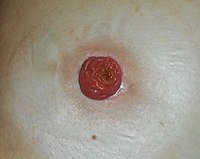
Photo from wikipedia
Background Anastomotic leakage is a fearsome complication in rectal surgery. Surgeons perform the classic air-leak test, although its real effectiveness is still debated. The aim of this study was to… Click to show full abstract
Background Anastomotic leakage is a fearsome complication in rectal surgery. Surgeons perform the classic air-leak test, although its real effectiveness is still debated. The aim of this study was to describe a personal technique of reverse air leak test in which low colorectal anastomosis were assessed transanally through the intra-rectal irrigation of a few mL of saline solution. Methods From October 2014 to November 2019 eleven patients with low rectal cancer (Type 1 in Roullier classification) were included in this study. At the beginning of the procedure, a circular anal dilator (CAD) was inserted into the anus. A side-to-end colorectal anastomosis was performed. A few mL of saline solution were injected into the rectum and the entire anastomotic line was directly explored. The appearance of bubbles was considered as an anastomotic defect and repaired with an interrupted suture. A fluorescence angiography after intravenous injection of Indocyanine green was performed in order to evaluate the perfusion of the anastomosis. Results In 4 cases (36.3%) the reverse air-leak test was positive. The defect was repaired and a confirmation test was performed. In all patients, near-infrared evaluation showed not perfusion defect (grade 0) in low colorectal anastomosis. No post-operative fistula was detected in cohort study. A protective stoma was performed in 10 patients. At 90-days there were no complications and stoma closure was performed as planned. Conclusion The reverse air-leak test is a simple, feasible and effective procedure to identify anastomotic leak in low colorectal anastomoses.
Journal Title: Annals of coloproctology
Year Published: 2020
Link to full text (if available)
Share on Social Media: Sign Up to like & get
recommendations!